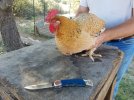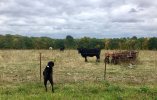Thanks, jb. This hen weighs 8.75 lb.. I processed this one and another using SK's new 110 w/ s90v steel. It sliced, skinned and malleted very well. Removed all the cuts at the joints except, separate thighs, split breast, decapitate and separate wishbone. These hens being on the large side, made it difficult for me to force the blade edge thru it's bones. So, I pounded it with the heel of my hand. Which only worked somewhat.
I then used the point of the knife and malleted that with my heel. This created a perforation type cut weakening the bone so I could then force the blade on thru. This worked. To decapitate I used a slicing motion cut. Which was a zip thru, at the first vertebra right below the jaw. A large neck bone but it cut completely thru in one slice. So, with little trauma and complete flush-out. I thought this knife preformed well on these hard cuts and did delicate work too. Like skinning, trimming fat off the gizzard and raking out internals. I had a poly cutting board under the chicken that prevented point damage during this processing. Still, I was concerned about this so, later I examined the point edge after clean up. And found there are burrs along the first 1/4" of the blade at this area. Which I'll easily strop off. Then after washing it I did not dry it.
Because I wanted to see how it handled water and bird oils. Hours later I examined it for rust specks. There were none.
Conclusion: I really liked the way this knife preformed and handled this work-load. Skinning and slicing is what a blade is built to do. Forcing a blade thru bones (ribs and those larger than a cigar) is no walk in the park for a blade to pull off. Fryers purchased in the store are half this size. It would do these-- no problem but these were the size of young turkey. So, making some of these cuts will be harder and this knife handled it. I'm pleased, I forced it to work hard in pulling this off. I still, prefer using my hatchet for some of this work coupled with a knife like this. I think those using it on a deer this fall will have no problems. Nor, will those using it around the home. A real winner and worth every penny I paid for it. The handle stayed grippy during all the work and I like it with no pin heads. Thank you SK. DM



